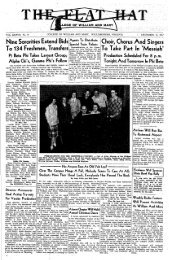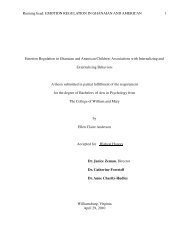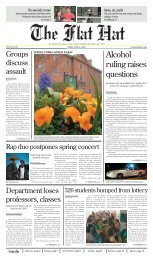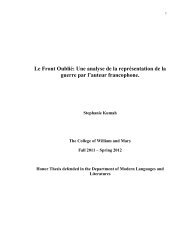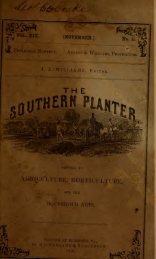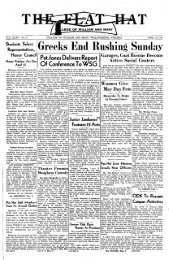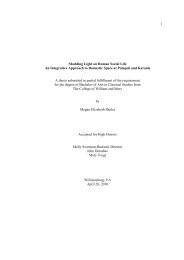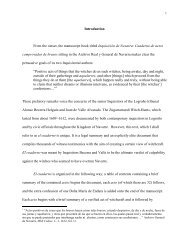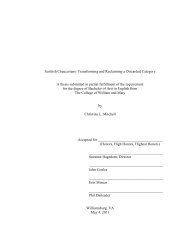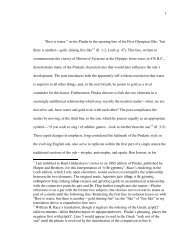Southern planter : devoted to agriculture, horticulture, and the ...
Southern planter : devoted to agriculture, horticulture, and the ...
Southern planter : devoted to agriculture, horticulture, and the ...
Create successful ePaper yourself
Turn your PDF publications into a flip-book with our unique Google optimized e-Paper software.
448 THE SOUTHERN PLANTER.<br />
both—let us cultivate all <strong>the</strong> l<strong>and</strong> of <strong>the</strong><br />
country which will pay lor such cultivation,<br />
but first let us improve <strong>the</strong> tillage of<br />
that which is now under culture, <strong>and</strong> look<br />
<strong>to</strong> advancing knowledge <strong>to</strong> aid us <strong>to</strong> develope<br />
<strong>to</strong> <strong>the</strong> utmost <strong>the</strong> latent powers of<br />
those fields which we have now in h<strong>and</strong>."<br />
Gardeners' Chronicle.<br />
An Amateur's View on <strong>the</strong> Propag-ation<br />
of Kew Varieties of Fruit.<br />
In a late number of <strong>the</strong> Horticulturist, W.<br />
Creed, of Rochester, N. Y., advances a new<br />
idea which may prove of great benefit <strong>to</strong> those<br />
who are engaged in <strong>the</strong> most praiseworthy effort<br />
<strong>to</strong> produce new <strong>and</strong> improved varieties of<br />
fruit, ei<strong>the</strong>r from natural or artificial fertiliza-<br />
tion. An experienced nurseryman can distinguish<br />
many varieties of <strong>the</strong> apple, pear, <strong>and</strong><br />
o<strong>the</strong>r fruit trees, by some peculiar characteristics<br />
of leaf, branch, color of bark or habit of<br />
growth, as well as he can distinguish one man<br />
from ano<strong>the</strong>r by his peculiar feature^, <strong>and</strong> in<br />
many of <strong>the</strong> varieties of apples, <strong>and</strong> pears particularly,<br />
we can determine <strong>the</strong>ir identity (<strong>and</strong><br />
<strong>the</strong>y may mostly all be learned) by any one of<br />
<strong>the</strong>se features, <strong>and</strong> with <strong>the</strong>m all combined <strong>the</strong><br />
mere novice may soon learn <strong>to</strong> distinguish<br />
<strong>the</strong>m.<br />
In regard <strong>to</strong> <strong>the</strong>se peculiar characteristics<br />
<strong>the</strong> writer assumes that " <strong>the</strong> most important<br />
contrast in <strong>the</strong>se distinguishing points, so far<br />
as <strong>the</strong> propagation of new varieties is concerned,<br />
is in <strong>the</strong> seeds <strong>the</strong>mselves ; take up your<br />
knife <strong>and</strong> half quarter a pear from each of <strong>the</strong><br />
above varieties named. Compare <strong>the</strong> seeds <strong>and</strong><br />
<strong>the</strong> contrast will be as equally convincing as in<br />
<strong>the</strong> fruit, foliage, &c. In reference <strong>to</strong> <strong>the</strong> seeds,<br />
however, we may expect that ninety-nine in a<br />
hundred in any particular variety closely resemble<br />
each o<strong>the</strong>r in shape, furm, fcc., peculiar<br />
<strong>to</strong> that variety, <strong>and</strong> producing seedlings exhibiting<br />
a close ajjiaily <strong>to</strong> each o<strong>the</strong>r, <strong>and</strong>, <strong>the</strong>refore,<br />
not likely <strong>to</strong> result satisfac<strong>to</strong>ry <strong>to</strong> <strong>the</strong> experimenter<br />
; but as soon as we find a marked difference<br />
in <strong>the</strong> formation of a single seed in any<br />
select variety, that seed should be chosen by <strong>the</strong><br />
amateur, for in that seed (which apparently is<br />
one of nature's freaks) is <strong>the</strong> symbol (in embryo<br />
of a new variety, whe<strong>the</strong>r "gooil," " very<br />
good," or " best," will be left for providence <strong>to</strong><br />
work out, man also doing his share in <strong>the</strong> matter.<br />
Ano<strong>the</strong>r part of <strong>the</strong> success, it is evident,<br />
will depend upon tlie choice of tiie best varie-<br />
ties, from Avhich <strong>to</strong> select one of <strong>the</strong>se ' freaks,'<br />
or * spurts,' which are more or less traceable<br />
throughout <strong>the</strong> wln)le classification of vegetable<br />
physiology, <strong>and</strong> intended by an all-wise Being<br />
<strong>to</strong> excite <strong>the</strong> wonder <strong>and</strong> admirat#n of man,<br />
prompting him <strong>to</strong> energetic action, <strong>and</strong> <strong>to</strong> study<br />
out <strong>the</strong> workings of nature in all its beauty <strong>and</strong><br />
complicity."<br />
Ileusoning from analogy, <strong>the</strong>re seems <strong>to</strong> be<br />
some plausibility in <strong>the</strong> <strong>the</strong>ory suggested. It<br />
is one of <strong>the</strong> established laws of nature that<br />
like nearly begets like. If we examine <strong>the</strong><br />
seeds of any specimen of a particular variety<br />
of pear or apple, we discover a striking similarity<br />
of form <strong>and</strong> color in <strong>the</strong>m, which renders<br />
<strong>the</strong> conclusion a safe one that <strong>the</strong> little filaments<br />
in <strong>the</strong> blossom, connected with <strong>the</strong> embryo<br />
of each seed, <strong>and</strong> which constitute <strong>the</strong><br />
pistils or female organs of <strong>the</strong> blossom, have<br />
been fertilized with pollen of <strong>the</strong> same variety,<br />
but in an orchard containing many kinds of <strong>the</strong><br />
same fruit, many of <strong>the</strong>se diff'erent varieties<br />
blossom at <strong>the</strong> same time, <strong>and</strong> <strong>the</strong> pollen is cast<br />
by <strong>the</strong> wind, or carried by insects from one tree<br />
<strong>to</strong> ano<strong>the</strong>r ; this coming in contact with a single<br />
filament or female organ of a fruit of a different<br />
variety, <strong>and</strong> some peculiarity of <strong>the</strong> male<br />
parent is at once stamped upon <strong>the</strong> seed in its<br />
embryotic state, <strong>and</strong> this peculiarity is extended<br />
<strong>to</strong> <strong>the</strong> future tree <strong>and</strong> fruit, producing a new<br />
variety, partaking in part of <strong>the</strong> combined characteristics<br />
of both parents more or less modified.<br />
This is an interesting question <strong>to</strong> <strong>the</strong> amateur<br />
<strong>and</strong> experimenter, in producing new varieties<br />
of fruit, <strong>and</strong> one, <strong>the</strong> truth of which,<br />
may be easily tested by an experiment in artificial<br />
impregnation. If <strong>the</strong> seeds produced in<br />
this manner differ materially from those impregnated<br />
on <strong>the</strong> same tree, in <strong>the</strong> natural way,<br />
it is safe <strong>to</strong> conclude that <strong>the</strong> difference was<br />
stamped upon <strong>the</strong>m by <strong>the</strong> male parent from<br />
ano<strong>the</strong>r variety.<br />
It is well known <strong>to</strong> intelligent fruit growers<br />
that <strong>the</strong>re are certain varieties of <strong>the</strong> apple,<br />
<strong>and</strong> of <strong>the</strong> peach particularly, that more surely<br />
produce <strong>the</strong>ir own kinds from seed than o<strong>the</strong>r<br />
varieties do. This is ei<strong>the</strong>r owing <strong>to</strong> <strong>the</strong> period<br />
of blossoming, earlier or later than <strong>the</strong> trees of<br />
<strong>the</strong> same class in general, which renders <strong>the</strong><br />
blossoms less liable <strong>to</strong> be fertilized from pollen<br />
from o<strong>the</strong>r trees, or <strong>to</strong> some peculiiirity of <strong>the</strong><br />
blossoms of <strong>the</strong> variety that is likely <strong>to</strong> prevent<br />
<strong>the</strong> contact of <strong>the</strong> fertilizing powder from o<strong>the</strong>r<br />
kinds.<br />
We give <strong>the</strong>se varioiis hints upon an interesting<br />
subject that experimenters may have <strong>the</strong>m<br />
in mind, with <strong>the</strong> hope that some light may be<br />
cast upon <strong>the</strong> subject.<br />
"We have arrived but at <strong>the</strong> threshold of investigation<br />
<strong>and</strong> scientific progress, <strong>and</strong> every<br />
new idea that is likeh' <strong>to</strong> aid investigation <strong>and</strong><br />
promote improvement is worthy of attention.<br />
Valley Farmer.<br />
Simple test for Guano.—A bushel of guano,<br />
if pure, weighs almost exactly seventy<br />
pounds ; if adulterated with light substances<br />
(which is rarely <strong>the</strong> case), it will,<br />
of course, weigh less. If clay, marl, s<strong>and</strong>,<br />
&c., have been used, <strong>the</strong>y will be materiall}'increased,<br />
<strong>and</strong> so far as this test applies,<br />
gross adulterations will be easily detected.



